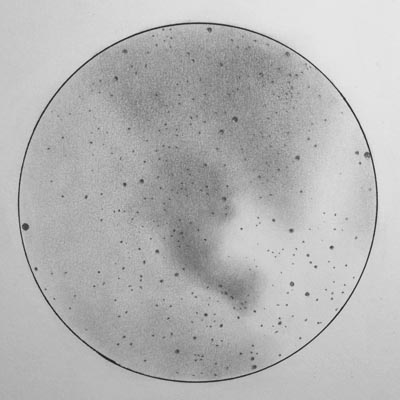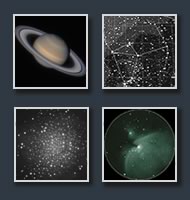North America Nebula (NGC 7000) - Sketch

Location and conditions: Negev desert (Borot Lutz), Israel, ~6.7 mag. sky.
Date: 29-30/07/2011
Instrument: Orion skyview pro 8" F/5 Newtonian. 2.1 degrees FOV.
Drawing details: Graphite pencil sketch on a white paper, made while observing with a telescope under a red light. Processed in Photoshop. The star colours were marked during the observation. Sketch by Michael Vlasov.
large nebula in middle-top: "North America Nebula" - NGC 7000; emission nebula.
size: 120' ; magnitude: 4 ; constellation: Cygnus ; distance: 2.2 Kly.
faint nebolocity at right edge: part of the "Pelican Nebula" (IC 5070). magnitude 8.
star cluster at top right: NGC 6997 open star cluster ; size: 7' ; magnitude: 10 ;
dark nebula at bottom-right: LDN 934 - the "Gulf of Mexico" ; opacity: 4/6
red star at left: Xi Cygni , 3.7 magnitude, colour index 1.63
blue star at right: 57 Cygni , 4.8 magnitude, colour index -0.16
Notes:
The North America nebula (NGC 7000) is a part of a large interstellar cloud in Cygnus, near it's "tail". It's shape clearly resembles North America continent, especially in it's southern part, with the spectacular "Gulf of Mexico" dark nebula. The orientation of the nebula to celestial north - matches the "real" north of the North American continent.
In this drawing - several objects are plotted (listed above). The most prominent feature in the eyepiece is the "Gulf of Mexico" dark nebula, with rather clearly defined edges where it "cuts" into the NGC 7000 nebula. There is another dark nebula, much less distinct, which bounds the "mexico" from south.
Despite it's brightness (magnitude 4) - NGC 7000 is often considered a difficult observing target due to several reasons: Very large size (2 degrees of arc) which is hard to fit into field of view. Relatively low surface brightness requires clear and dark sky. The fact that it's located in the milky way doesn't help either, and can be dealt with by using a narrowband filter. However under moderately dark skies, with UHC (or O3) filter and with appropriate instruments, It can be stunning. The instrument should have enough light graps and large field of view (large refractors, binoculars, or fast newtonians). This nebula can also be observed with a naked eye, under transparent and dark skies.
Original drawing:


